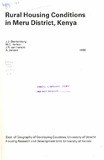| dc.description.abstract | Housing conditions in rural areas of the Third World countries receive very little attention, particularly if compared with the proportional
share in the total populations of these countries. In both studies and policy measures, the emphasis is put on the urban environment, with
priority for the bigger cities. This situation is also found in Sub- Saharan Africa~ The increased attention for housing in general which
can be observed during the last decade did not change this urban bias. Various factors contribute to this urban bias, such as the
assumed better housing conditions in the rural areas if compared to the urban slums and squatter settlements; development policies which
in spite of all verbal commitments to basic needs, still concentrate heavily on economic growth only with dominant attention for so-called modern production activities and consequent priority for urban areas, and probably as most important factor - the disproportionate political influence of the urban-based segments of the population. | en_US |



